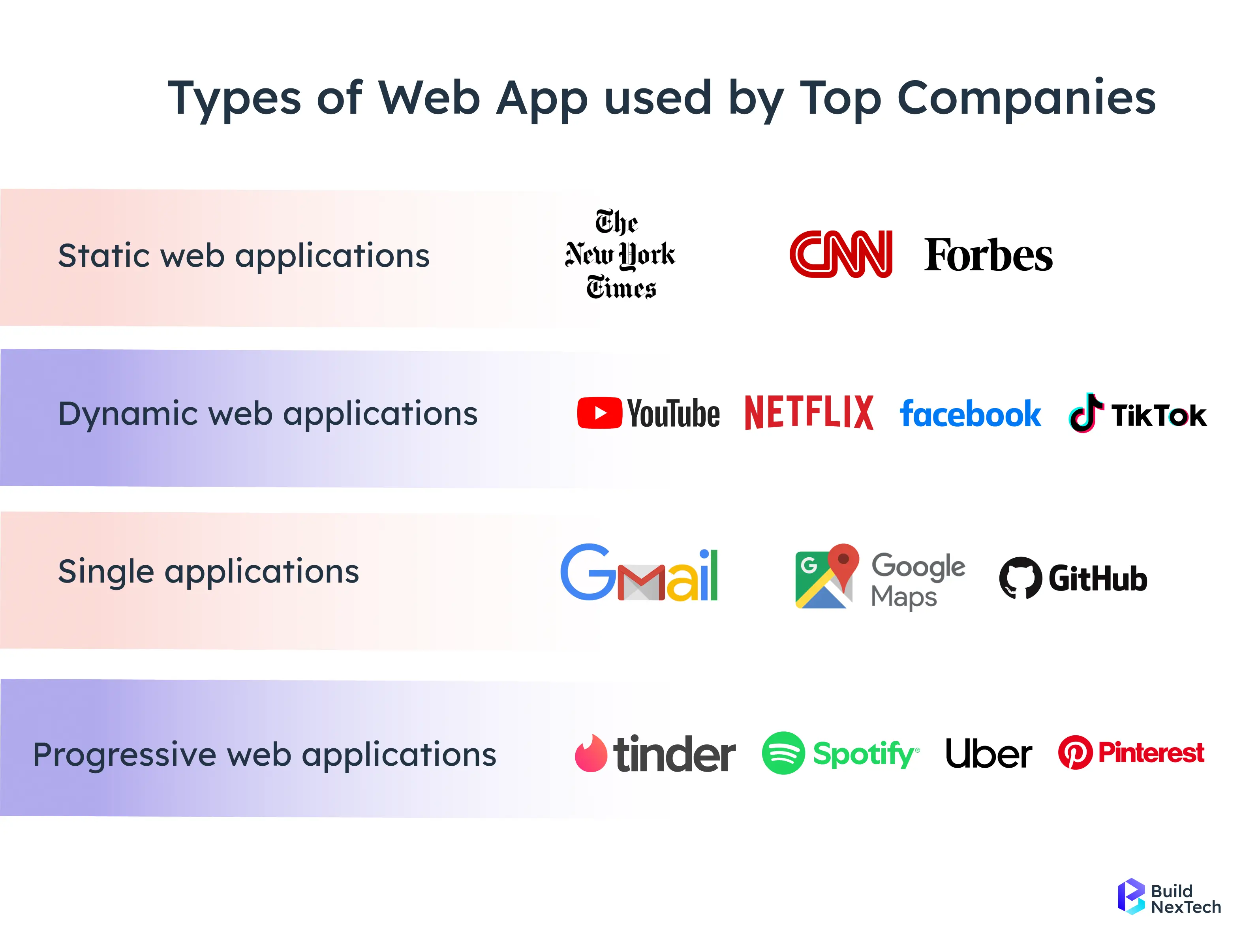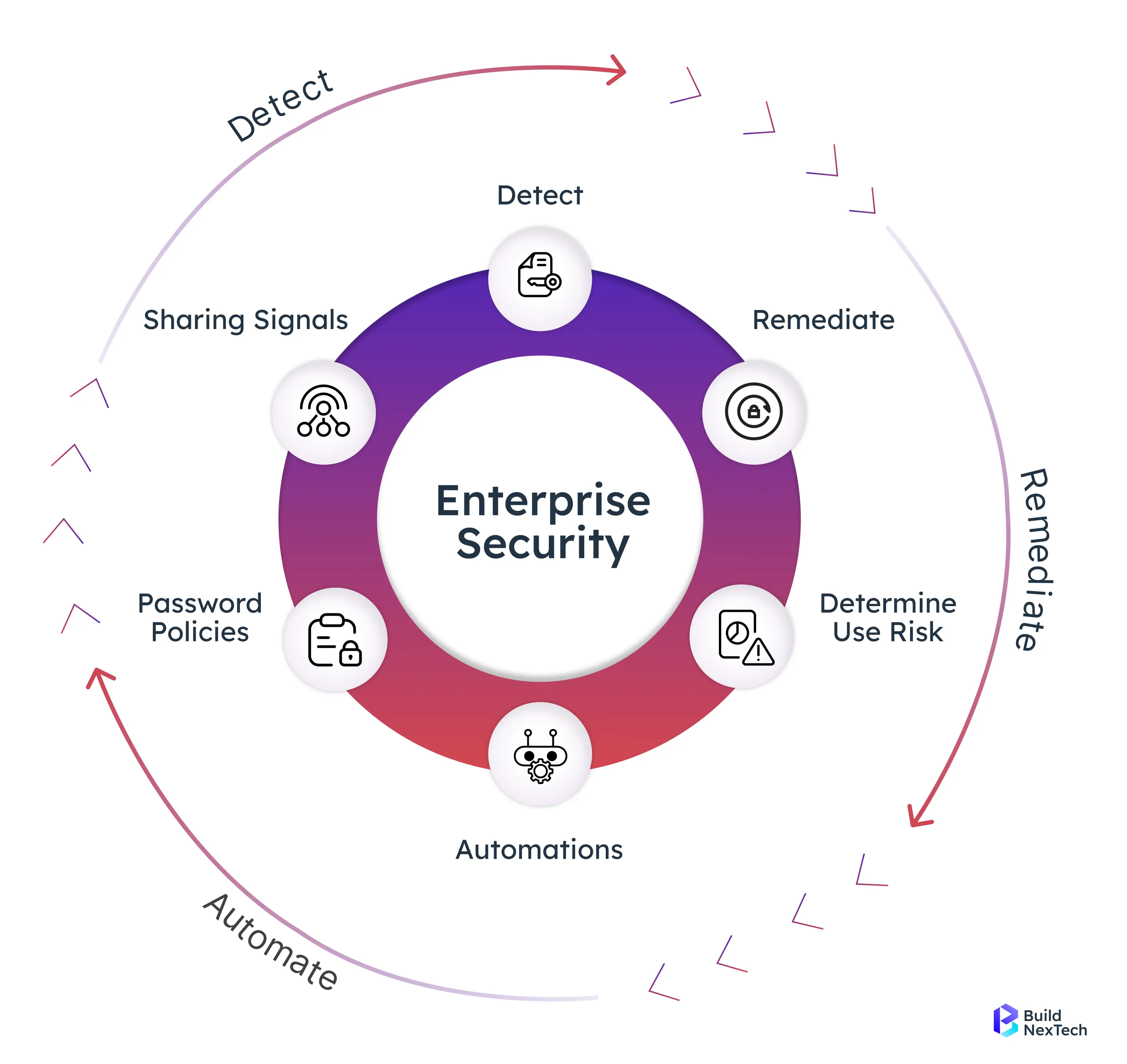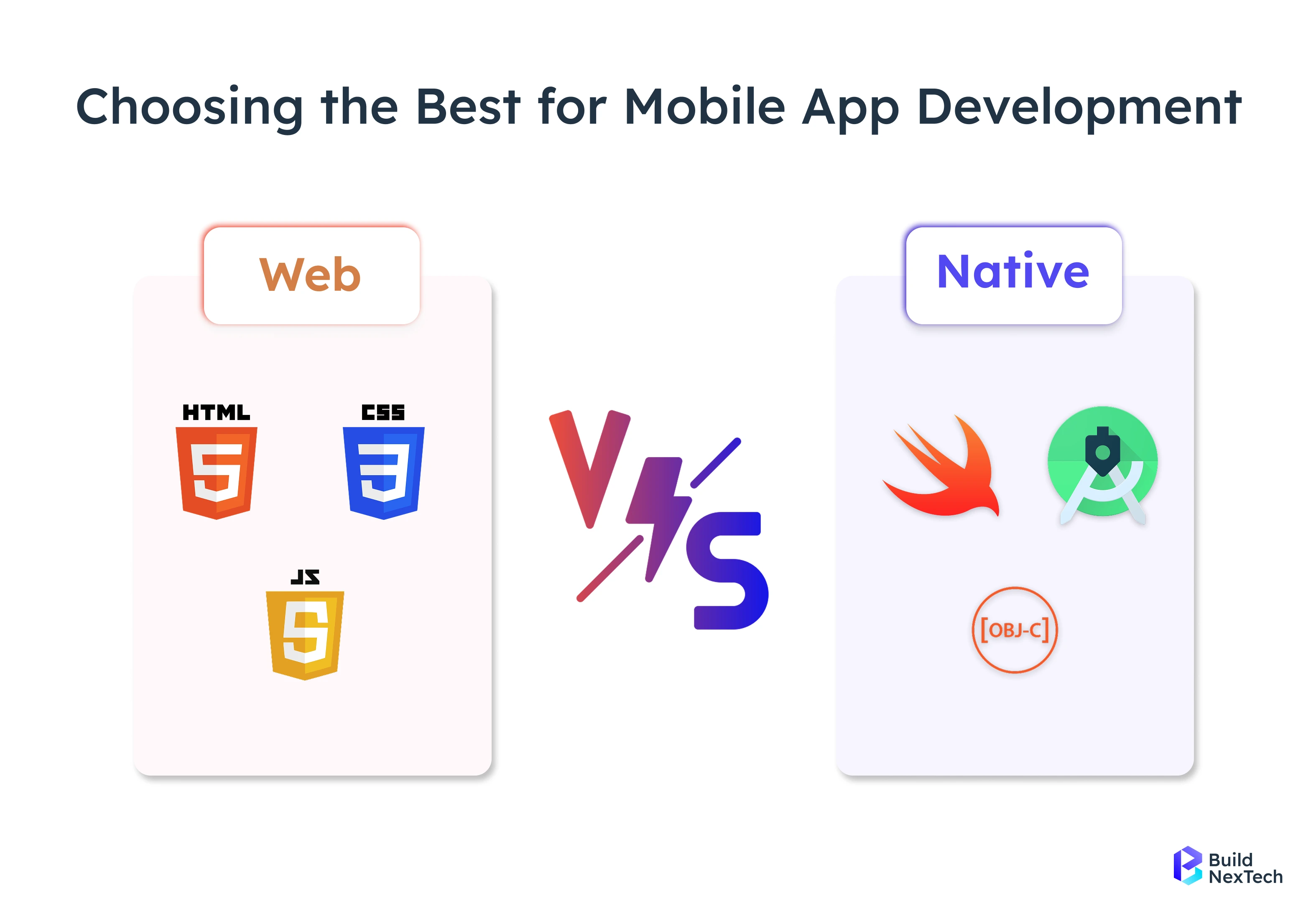In today’s fast-changing tech world, think of choosing a web app, native app, or hybrid solution as more than just a tech choice. Your choice will determine how fast you launch, how users react to your app, and how it grows with your organization. Nearly 5 billion people use mobile internet. B2B companies are creating new roles and enhancing digital tools. This means a CTO must think beyond just coding an app.
💡 Here’s what you’ll get from this article:
📌 A clear breakdown of how web and native apps work for B2B companies
📌 The pros, cons, and costs of each option
📌 What Progressive Web Apps (PWAs) are and when to use them
📌 Real-life examples from industries like logistics and retail
📌 A simple decision guide to help you pick the right type of app
📌 Expert tips from BuildNexTech, a top React Native app development company in the U.S.
What Are Web Applications and How They Serve B2B Needs
Think of web applications as the Swiss Army knife of the digital world. They run entirely in web browsers without requiring installation from app stores, which means your team can access them instantly from any mobile devices with mobile internet connectivity. Built using standard web technologies like HTML, CSS, and JavaScript, they're like having a reliable tool that works everywhere.

Here's why businesses love web apps:
- Works on everything - Whether your team uses iPhones, Android tablets, MacBooks, or PCs, everyone gets the same experience
- Single codebase to rule them all - Your developers only need to maintain one version, which saves you serious money
- Updates happen like magic - No more nagging users to update their apps; changes roll out automatically
- Built-in security - HTTPS protocols keep your data safe during transmission
- One-step access - Your team can access everything with a simple bookmark through their web browser
- Looks great everywhere - Automatically adjusts to different screen sizes across mobile devices
- Cost-efficient, faster time to market - Get to market months ahead of native solutions with a slower time for competitors to catch up
Native Mobile Apps in the B2B Context
Native mobile applications are like having a custom-tailored suit for each platform. iOS apps speak Swift or Objective-C fluently, while Android apps are fluent in Java or Kotlin. Each mobile device type gets its own specially crafted code that knows exactly how to make the most of that device's unique capabilities and device features.
Why enterprises choose native apps:
- Performance that purrs - Optimized specifically for each platform's strengths
- Full backstage access - Tap into everything from cameras to GPS to fingerprint scanners and other device features
- Store credibility - Available through trusted App Store and Google Play channels
- Works offline - Perfect for field teams who can't always count on network connectivity
- Fort Knox security - Platform-level protection keeps your sensitive data locked down
- Hardware harmony - Seamlessly integrates with device capabilities for demanding tasks
- Battery power friendly - Optimized to sip power, not gulp it
- All the bells and whistles - Access every sensor, storage option, and advanced feature
Progressive Web Apps: The Middle Ground
Progressive Web Apps (PWAs) are the diplomatic peacekeepers between web applications and native mobile apps. They're like having your cake and eating it too - you get web accessibility mixed with native-like superpowers. Using clever technologies like Service Workers and Web App Manifest files, PWAs offer the flexibility your business needs across different mobile devices.
What makes PWAs special for B2B:
- Real-time alerts - Push notifications keep your team in the loop instantly
- Offline superhero - Critical business operations continue even without mobile internet
- Native feel, web flexibility - Looks and acts like a real app across all devices
- Lightning fast - Smart caching makes everything load quicker
- No app store drama - Install directly without jumping through approval hoops
- Server-side smarts - Optimized remote server-side code that adapts to your needs
- Best of both worlds - Hybrid functionality with web convenience
Cost Analysis and Development Timeline Considerations
Web App Development Costs and Resources
Here's some music to your CFO's ears: According to Statista, web application development typically costs 40-60% less than native app development for the same features. It's like getting a luxury car at economy pricing because you're sharing resources smartly with a single codebase approach.
Why web apps are budget-friendly:
- One team handles everything instead of separate iOS and Android squads
- Testing is simpler when you're not juggling multiple platforms
- Maintenance headaches disappear with unified codebases
- Skip the app store fees and approval waiting games
- Faster time to market (2-4 months faster) while competitors face a slower time to deployment
Native App Development Investment
Native applications are like hiring separate specialists for each job - it costs more upfront, but you get expertise tailored to each platform. While your wallet might feel lighter initially, you often get superior performance and user experience for complex B2B applications that justify the investment, especially when your customer base demands the best mobile experience.
What you're investing in with native apps:
- Dedicated teams for iOS and Android (double the specialists)
- Separate testing cycles for each platform
- App store fees and the patience for approval processes
- Ongoing maintenance for multiple codebases (think of it as caring for twins)
- Higher long-term costs, but potentially higher returns
SaaS Development as an Alternative Approach
Many smart B2B companies are jumping on the Software-as-a-Service bandwagon, leveraging web technologies for rapid deployment and scalability. It's like renting a fully-furnished apartment instead of buying and furnishing your own house - you get enterprise-grade security and performance without the infrastructure headaches, perfect for growing your customer base efficiently.
Performance, Security, and Scalability for Enterprise Use
For enterprises, choosing the right application type goes beyond features — it’s about ensuring performance, protecting sensitive data, and scaling seamlessly as the business grows. CTOs and decision-makers must evaluate how well a solution can handle heavy workloads, maintain airtight security, and adapt to evolving customer demands in competitive B2B environments.

Web Application Performance in B2B Environments
Don't let anyone tell you web applications are sluggish anymore. Modern web apps are performance athletes, thanks to advanced optimization techniques. Frameworks like React and Angular create user interfaces so smooth they rival native experiences across every screen size and device type your team uses, whether they're accessing through mobile internet or high-speed connections.
How web apps stay lightning-fast:
- Global speed boost - Content delivery networks (CDNs) make everything accessible worldwide
- Smart loading - Progressive techniques improve user experience dramatically
- Memory magic - Web browser caching makes return visits incredibly fast
- Server-side rendering - Your first impression loads in a blink
- Mobile-first thinking - Designed for smartphones, enhanced for everything else
- Image intelligence - Optimization and lazy loading keep things snappy
- Code efficiency - Smart splitting reduces initial load times
Native App Performance and Security Standards
When you need the digital equivalent of a Formula 1 race car, native applications deliver. They speak directly to device hardware, making them perfect for B2B solutions that demand intensive data processing or real-time interactions. It's like having a direct hotline to your device's full capabilities, even when network connectivity is spotty.
Native app security advantages:
- Platform-level protection - Built-in security controls and encryption
- Biometric integration - Fingerprints, face recognition, and ARKit/ARCore capabilities
- Vault-level storage - Secure data in device keychain and protected memory
- Attack prevention - Protection against cross-site scripting and SQL injection
- Network control - Enhanced oversight of connectivity and data transmission
- Hardware security - Leverage built-in security features
- Advanced authentication - Camera and sensor integration for secure access
- Bulletproof packaging - Secure management and version control
Scalability Considerations for Growing Businesses
Web applications are like elastic waistbands - they grow with you effortlessly. As your customer base expands, cloud-based architectures and containerization technologies enable seamless scaling without platform-specific headaches. They support your global growth ambitions across different markets and device preferences, making digital transformation smoother for enterprises.
User Experience and Engagement Strategies
Mobile App Engagement Strategy for B2B Users
Here's a compelling statistic that might surprise you: Native mobile apps consistently show 3x higher session duration compared to mobile web experiences in enterprise environments. That's like the difference between a quick coffee chat and a deep strategy session - native apps keep users engaged for complex business tasks and workflows, especially when they need offline features.
How to maximize engagement:
- Instant alerts - Push notifications for critical business updates
- Offline reliability - Keep field operations running without mobile internet worries
- Intuitive flow - Navigation designed specifically for mobile workflows
- Smart integration - Connect with device contacts and calendar systems
- Personal touch - Customizable dashboards and user preferences
- Advanced features - Leverage device capabilities for enhanced interaction
- Quick access - Biometric authentication gets users in fast and securely
- Smart scanning - Camera integration for document processing and recognition
Web App User Experience Optimization
Web applications are the chameleons of the digital world - they adapt perfectly to any environment through responsive web browser interfaces. This consistency is gold for B2B solutions where your team bounces between smartphones, desktop computers, and tablets throughout their busy workday, regardless of their device of choice.
Web app UX best practices:
- Seamless transitions - Responsive design that works everywhere
- Network adaptability - Progressive enhancement handles varying mobile internet speeds
- Power user friendly - Keyboard shortcuts for desktop efficiency
- Browser integration - Bookmarks and history make navigation effortless
- Cross-device sync - Pick up where you left off on any device
- Touch and click optimization - Perfect interaction whether using fingers or mouse
- Screen flexibility - Adapts beautifully to any display size
- Speed optimization - Web browser code that loads lightning-fast
Marketing and Monetization Considerations
Mobile App Marketing Strategy for B2B Solutions
Native apps get the VIP treatment in app stores with built-in discoverability and organic search within iOS App Store and Google Play. But here's the twist - B2B apps usually rely more on direct relationships and sales channels than random consumer discovery, especially when targeting social networking platforms or OTT platforms for business use.
Effective B2B app marketing:
- Enterprise distribution - Deploy through business app stores
- Direct deployment - Use mobile device management (MDM) for controlled rollouts
- Ecosystem integration - Connect with existing business software environments
- Professional networking - Targeted LinkedIn and industry publication advertising
- Face-to-face impact - Trade show demonstrations and pilot programs that let prospects experience value firsthand
- Market research - Understanding your target audience's preferences and behaviors
Mobile App Monetization Strategy Options
B2B applications typically embrace subscription models rather than one-time purchases or advertising revenue. It's like having a reliable monthly relationship instead of a one-night stand - this approach aligns perfectly with ongoing support and feature development your enterprise customers expect, similar to how Jio Money has built sustainable revenue streams.
Smart monetization strategies:
- Scalable subscriptions - Tiered models based on user count
- Feature-based pricing - Pay for what you need, upgrade when you grow
- Enterprise licensing - Custom integrations for big clients
- Professional services - Implementation support that adds real value
- White-label opportunities - Partner solutions that expand your reach
Choosing the Right Development Partner
Evaluating Mobile App Development Agency Capabilities
Picking the right development partner is like choosing a business marriage - it significantly impacts your project's success and your sanity. Look for agencies with proven B2B battle scars, relevant industry certifications, and comprehensive UI UX design services that truly understand the key differences between web and native development approaches. They should also offer software testing services to ensure quality delivery.
What to look for in a partner:
- Proven track record - Portfolio of successful B2B application deployments
- Technical chops - Expertise in your required platforms and programming languages
- Security credentials - Certifications and compliance experience that matter
- Long-term support - Post-launch maintenance capabilities (because launch is just the beginning)
- Industry understanding - Knowledge of your sector's regulatory requirements
- Research capabilities - Market research skills for target audience insights
- Framework flexibility - Experience with different application development approaches
- Strategic guidance - CTO as a Service offerings for ongoing technical leadership
Web Development Company vs Specialized Providers
Here's a common crossroads: choosing between full-service web development companies and specialized mobile app development agencies. It's like deciding between a general practitioner and a specialist - each approach offers distinct advantages depending on your specific needs, device preferences, and long-term technology vision. Some agencies even offer Solutions for Application Development & DevOps Library services or Amplify Hosting to streamline your deployment process.
Why full-service providers make sense:
- Unified vision - Integrated approach to web and mobile development
- Consistent experience - Design and user experience harmony across platforms
- Simplified management - One point of contact, one relationship to manage
- Budget efficiency - Potential cost savings through bundled services
- Strategic partnership - Long-term relationship for ongoing digital evolution
- Complete solutions - Coverage across multiple technology types
- Broad expertise - Knowledge in both browser-based and native solutions
- Comprehensive support - Help with various mobile applications and web services
Making the Final Decision: Framework for CTOs
Selecting the right approach to mobile app development is not just a technical decision — it’s a strategic one. CTOs must balance cost, performance, scalability, and long-term business goals while ensuring that the chosen solution aligns with user needs and market dynamics. A structured framework helps cut through the noise and provides a clear path to making an informed, future-proof choice.

Decision Matrix for Web vs Native vs Hybrid Solutions
Creating a structured evaluation framework is like having a GPS for your technology journey - it ensures you consider all the important factors without getting lost in the details. Weight each criterion based on your specific business priorities, constraints, and the unique challenges your organization faces in today's competitive landscape.
Your evaluation toolkit:
- Budget reality check - Total cost of ownership analysis that includes hidden costs
- User preferences - Target audience device habits and usage patterns
- Feature requirements - Essential functionality and device access needs
- Performance expectations - Speed and user experience standards your team demands
- Security mandates - Industry compliance requirements that aren't negotiable
- Timeline pressures - Competitive forces and market timing considerations
- Integration complexity - How well solutions play with existing systems and services
- Growth planning - Scalability needs for future expansion and customer base growth
- Talent availability - Developer expertise and programming language capabilities
Implementation Roadmap and Success Metrics
Once you've made your technology choice, it's time to create a comprehensive game plan with clear milestones and measurable success metrics. Think of this roadmap as your project's GPS - it should address both technical achievements and business objectives while anticipating potential roadblocks and version control challenges.
Implementation essentials:
- Smart rollout - Phased strategy that minimizes risk and maximizes learning
- Change management - User training and adoption processes that actually work
- Performance tracking - Analytics implementation that provides actionable insights
- Security validation - Testing and compliance checks that protect your business
- Feedback loops - Collection and improvement processes that keep you evolving
- Deployment strategy - Package management and release approaches
- Integration testing - Ensuring seamless operation with existing business systems
- Optimization focus - Performance tuning across all device types your users love
Conclusion: Making the Strategic Choice That Drives B2B Success
Choosing between web apps and native applications is a strategic decision impacting scalability, user satisfaction, and time to market. Web apps work best for broad accessibility, lower costs, and rapid deployment, while Progressive Web Apps (PWAs) provide a smart middle-ground for quick cross-platform rollout. Native apps, however, excel in performance-heavy use cases, offline access, and complex workflows—ideal for field service tools, real-time dashboards, and platforms needing full device features.
At BuildNexTech, a leading React Native mobile app development company, we’ve delivered solutions across logistics, travel, and retail. As a trusted React Native application development company and React Native development company in USA, we provide end-to-end React Native app development services tailored to business goals. Whether you want to hire React Native app developer talent for pilot projects or need full support from a React Native app development agency or React Native development agency, our expertise ensures measurable ROI. From single codebase optimization to custom workflows, our React Native app development company in USA guarantees scalable, future-ready outcomes with every React Native app development service we deliver.
People Also Ask
What Are the Hidden Costs of Mobile App Development vs Web Development?
Mobile apps often include hidden costs like app store fees, device testing, maintenance across platforms, and frequent updates, whereas web apps are cheaper to maintain but may lack deep device integration.
Can Progressive Web Apps Replace Native Apps for B2B Solutions?
PWAs can replace native apps in many B2B use cases with simpler requirements, but may fall short for complex offline access, performance, or hardware-level features.
What's the Timeline Difference Between Web App and Native App Development?
Web apps can be built and deployed faster since they skip app store approvals and support a single codebase, while native apps typically take longer due to platform-specific development.
Which Platform Should B2B Companies Prioritize: iOS, Android, or Web?
B2B companies should prioritize the platform their target users rely on most—web for cross-device access, iOS for enterprise-heavy regions, and Android for wider global reach.


























.webp)
.webp)
.webp)

